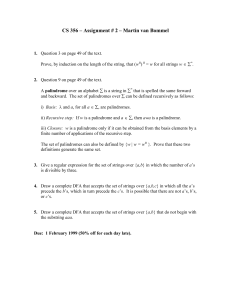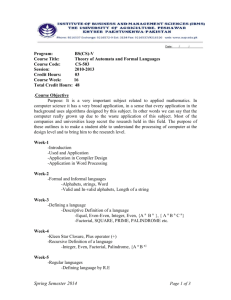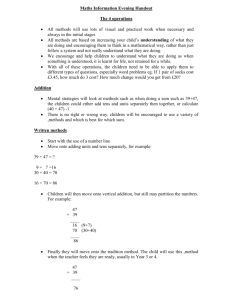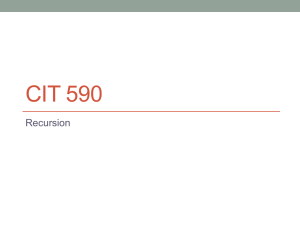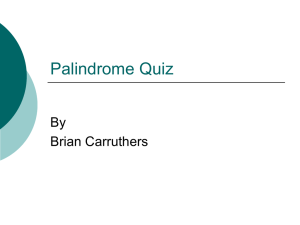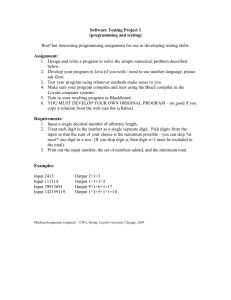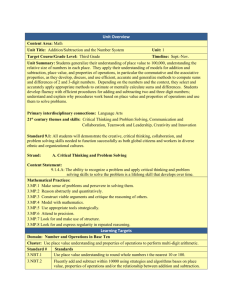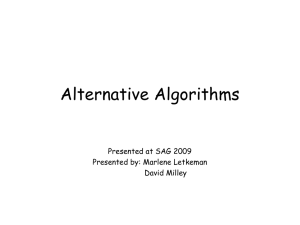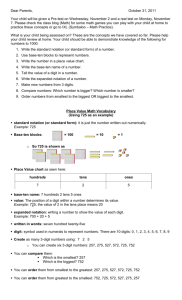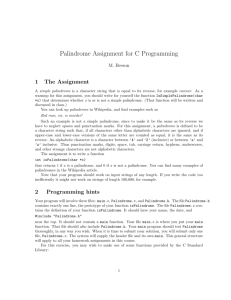1: 12 Algorithms For Addition And Subtraction Of Whole Numbers
advertisement
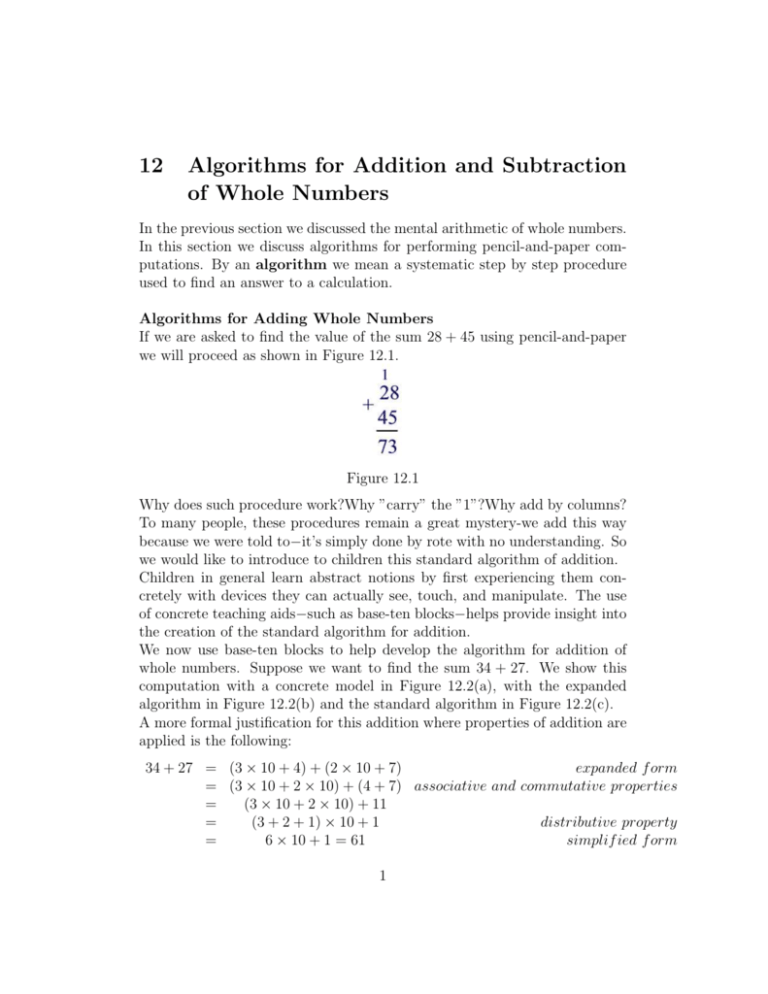
12 Algorithms for Addition and Subtraction of Whole Numbers In the previous section we discussed the mental arithmetic of whole numbers. In this section we discuss algorithms for performing pencil-and-paper computations. By an algorithm we mean a systematic step by step procedure used to find an answer to a calculation. Algorithms for Adding Whole Numbers If we are asked to find the value of the sum 28 + 45 using pencil-and-paper we will proceed as shown in Figure 12.1. Figure 12.1 Why does such procedure work?Why ”carry” the ”1”?Why add by columns? To many people, these procedures remain a great mystery-we add this way because we were told to−it’s simply done by rote with no understanding. So we would like to introduce to children this standard algorithm of addition. Children in general learn abstract notions by first experiencing them concretely with devices they can actually see, touch, and manipulate. The use of concrete teaching aids−such as base-ten blocks−helps provide insight into the creation of the standard algorithm for addition. We now use base-ten blocks to help develop the algorithm for addition of whole numbers. Suppose we want to find the sum 34 + 27. We show this computation with a concrete model in Figure 12.2(a), with the expanded algorithm in Figure 12.2(b) and the standard algorithm in Figure 12.2(c). A more formal justification for this addition where properties of addition are applied is the following: 34 + 27 = (3 × 10 + 4) + (2 × 10 + 7) expanded f orm = (3 × 10 + 2 × 10) + (4 + 7) associative and commutative properties = (3 × 10 + 2 × 10) + 11 = (3 + 2 + 1) × 10 + 1 distributive property = 6 × 10 + 1 = 61 simplif ied f orm 1 Figure 12.2 Next, we explore a couple of algorithms that have been used throughout history. Lattice Algorithm We explore this algorithm by looking at an example such as the one given in Figure 12.3. Figure 12.3 To use this algorithm you add single digit number to a single digit number from right to left and record the results in a lattice as shown. Then the sums are added along the diagonal. 2 Scratch Algorithm Consider the sum shown in Figure 12.4. Figure 12.4 Begin by adding from the top down in the units column. When you add a digit that makes your sum 10 or more, scratch out the digit as shown and make a mental note of the units digit of your present sum. Start with the digit noted and continue adding and scratching until you have completed the units column, writing down the units digit of the last sum as the units digit of the answer as shown. Now, count the number of scratches in the units column and, starting with this number, add on down the tens column repeating the scratch process as you go. Continue the entire process until all the columns have been added. This gives the desired answer. Practice Problems Problem 12.1 Use the addition expanded algorithm as discussed in this section to perform the following additions: (a) 23 + 44 (b) 57 + 84 (c) 324 + 78 Problem 12.2 Use base ten blocks to represent the sum 279 + 84. Problem 12.3 State the property that justifies each of the following steps. 36 + 52 = = = = = = = = = (3 · 10 + 6) + (5 · 10 + 2) 3 · 10 + [6 + (5 · 10 + 2)] 3 · 10 + [(6 + 5 · 10) + 2] 3 · 10 + [(5 · 10 + 6) + 2] 3 · 10 + [5 · 10 + (6 + 2)] (3 · 10 + 5 · 10) + (6 + 2) (3 + 5) · 10 + (6 + 2) 8 · 10 + 8 88 3 Problem 12.4 Find the missing digits. Problem 12.5 Julien Spent one hour and 45 minutes mowing the lawn and two hours and 35 minutes trimming the hedge and some shrubs. How long did he work all together? Problem 12.6 Compute the sum 38 + 97 + 246 using scratch addition. Problem 12.7 Find the sum 3 hr 36 min 58 sec + 5 hr 56 min 27 sec. Problem 12.8 Compute the following sums using the lattice method. (a) 482 + 269 (b) 567 + 765. Problem 12.9 Larry, Curly, and Moe each add incorrectly as follows. How would you explain their mistakes to each of them? Problem 12.10 A palindrome is any number that reads the same backward as forward, for example, 121 and 2332. Try the following. Begin with any number. Is it a palindrome? If not, reverse the digits and add this new number to the old one. Is the result a palindrome?If not, repeat the above procedure until a palindrome is obtained. For example, suppose you start with 78. 4 Because 78 is not a palindrome, we add 78 + 87 = 165. Since 165 is not a palindrome we add 165 + 561 = 726. Since 726 is not a palindrome we add 726 + 627 = 1353. Since 1353 is not a palindrome we add 1353 + 3531 = 4884 which is a palindrome. Try this method with the following numbers: (a) 93 (b) 588 (c) 2003. Problem 12.11 Another algorithm for addition uses the so-called partial sums. The digits in each column are summed and written on separate lines as shown below. Using this method, compute the following sums: (a) 598 + 396 (b) 322 + 799 + 572. Algorithms for Subtracting Whole Numbers As with addition, base-ten blocks can provide a concrete model for subtraction. Suppose we want to find the difference 375 − 243. Figure 12.5(a) shows the computation with a concrete model, Figure 12.5(b) with an expanded algorithm, and Figure 12.5(c) with the standard algorithm. Figure 12.5 5 Example 12.1 (Subtracting with exchanging) Use the three algorithms dicussed above to subtract 185 from 362. Solution (a) With base ten blocks: We start with three mats. 6 strips, and 2 units. We want to take away 1 mat, 8 strips, and 5 units. Since we cannot pick up 5 units from our present arrangement, we exchange a strip for 10 units to obtain 3 mats, 5 strips, and 12 units. We can now take away 5 units, but we still cannot pick up 8 strips. Therefore, we exchange a mat for 10 strips to obtain 2 mats, 15 strips, and 12 units. Finally we are able to take away 1 mat, 8 strips, and 5 units as shown. 6 Practice Problems Problem 12.12 Sketch the solution to 42 − 27 using base-ten blocks. Problem 12.13 Peter, Jeff, and John each perform a subtraction incorrectly as follows: How would you explain their mistakes to each one of them? Problem 12.14 Find the difference 5 hr 36 min 38 sec − 3 hr 56 min 58 sec. Problem 12.15 In subtracting 462 from 827, the 827 must be regrouped as tens, and ones. hundreds, Problem 12.16 Suppose you add the same amount to both numbers of a subtraction problem. What happens to the answer? Try the following. (a) What is 86 − 29? (b) Add 11 to both numbers in part (a) and subtract. Do you obtain the same number? Problem 12.17 The equal-addition algorithm has been used in some US schools in the past 60 years. The property developed in the preceding problem is the basis for this algorithm. For example, in computing 563 − 249, one needs to add 10 to 3. To compensate, one adds 10 to 249. Then the subtraction can be done without regrouping as shown in the figure below. Compute the difference 1464 − 687 using the equal-addition algorithm. 7 Problem 12.18 Sketch the solution to 275 − 136 using base ten blocks. Problem 12.19 Use the expanded algorithm to perform the following: (a) 78 − 35 (b) 75 − 38 (c) 414 − 175 Problem 12.20 Fill in the missing digits. Problem 12.21 After her dad gave her her allowance of 10 dollars, Ellie had 25 dollars and 25 cents. After buying a sweater for 14 dollars and 53 cents, including tax, how much money did Ellie have left? Problem 12.22 A hiker is climbing a mountain that is 6238 feet high. She stops to rest at 4887 feet. How many more feet must she climb to reach the top? 8

